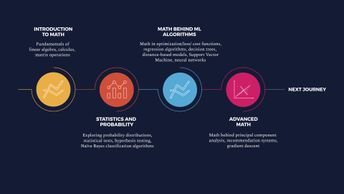Final Exam: Math Behind ML Algorithms - analyze the data used to implement a classification model using K Nearest Neighbors
- apply the gradient descent algorithm to solve for the optimum hyperplane
- build and evaluate an SVM classifier and recognize the importance of scaling the inputs to such a model
- calculate an S-curve in logistic regression
- calculate R-squared of a regression model
- calculate the Euclidean and Manhattan distance between two points using SciPy as well as your own function
- classify test data points using your own KNN classifier and evaluate the model using a variety of metrics
- code the individual steps involved in performing a clustering operation using the K-means algorithm
- compute the best fit with partial derivatives
- compute the weighted sum of inputs with bias
- contrast rule-based and ML-based classifiers
- create a simple neural network with one neuron for regression
- decide splits for a rule-based decision tree
- define a function that clusters the points in a dataset using the K-means algorithm and then test it
- define and calculate GINI impurity
- define and understand entropy
- define and understand information gain
- define and visualize two points in a two-dimensional space using Python
- define a rule-based decision tree
- describe how unstable gradients can be mitigated using variants of the ReLU activation function
- describe the Hamming and Cosine distance metrics
- discuss residuals in regression
- discuss the normal equation
- explore gradients
- explore least square error
- generate a heatmap to visualize the correlations between features in a dataset
- identify correlations for performing logistic regression
- illustrate ReLU, Leaky ReLU, and ELU activation functions
- illustrate step, sigmoid, and tangent activation functions
- illustrate the classification dataset
- illustrate the impact of learning rate and number of epochs of training
- implement a function that classifies a point using the K Nearest Neighbors algorithm
- implement a single epoch
- introduce decision trees for continuous values
- introduce gradient descent
- introduce the classification problem
- load a dataset from a CSV file into a pandas DataFrame and analyze it in preparation for binary classification
- Mathematical operation of a neuron
- outline how SVMs can be used to classify data, how hyperplanes are defined, and the qualities of an optimum hyperplane
- perform regression and view the predicted values
- process data in batches and with multiple layers
- recall characteristics of GINI impurity
- recall how distance-based models work at a high level and identify the use cases of such models
- recall the architecture and components that make up neural networks
- recall the characteristics of activation functions
- recall the qualities of an optimum hyperplane, outline how scaling works with SVM, distinguish soft and hard margins, and recognize when and how to use either margin
- recall the structure of a decision tree
- recall the techniques that can be applied to classify data that are not linearly separable
- recognize the place of support vector machines (SVMs) in the machine learning landscape
- recount how the KNN and K-means algorithms use distance metrics to perform ML operations
- separate a dataset into training and test sets
- set up training and testing data for logistic regression
- split decision trees based on GINI impurity
- split train and test data and create computations
- standardise and shape data for gradient descent
- train an ML-based decision tree
- use boxplots, a pair plot, and a heatmap to analyze a dataset in preparation for training a regression model
- use scikit-learn to generate blob data that is linearly separable
- visualize correlations of features
- work through a calculation of an epoch
|


